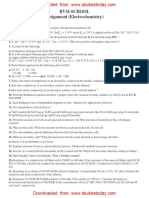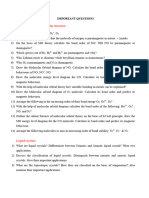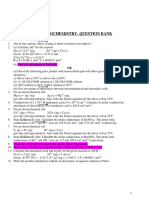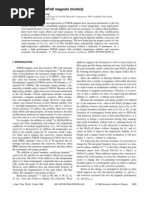Practice Set - 4
Uploaded by
rishavkmPractice Set - 4
Uploaded by
rishavkmMSE303: Electronic and Magnetic Properties of Materials
Practice Problems Set 4
Topics covered: Ionic Conductivity
1. Show that for metal-deficient non-stoichiometric ionic oxide (MO), concentration of holes is
proportional to partial pressure of oxygen as
! !!! !
for both metal-deficient and oxygen-excess cases.
2. LiF has a Schottky formation energy of 2.6 eV and a bandgap of 12 eV. Write defect reaction for
Schottky defect formation for LiF. Estimate the relative concentrations of ionic and electronic
defects at 500 and determine which are dominant on an absolute concentration basis. (assume
3. Uranium dioxide, UO2 is of the fluorite structure. Thy oxygen ions occupy tetrahedral sites in an
FCC lattice of uranium ions, leaving octahedral interstitial sites empty. Some relevant defect
formation energies and other useful information are as follows:
! ! + !!! = 3.0
! !!!!! + ! = 9.5
2! + ! !!!!! + ! + ! +! = 6.4
! = 5.2
(a) What are the predominant intrinsic ionic defects in stoichiometric UO2 at 1600 ? Calculate
their concentrations.
(b) Calculate the intrinsic electron and hole concentration at the same temperature. (Assume that the
bandgap decreases with temperature at the rate of ~1 meV/K and effective densities of states in
conduction and valence bands is 1x1019 /cm3.)
(c) UO2 is easily rendered extrinsic by reduction to UO2-x or oxidation to UO2+x at high temperatures.
Write defect reactions for reduction and oxidation of UO2. How does defect formation depend on
oxygen partial pressure in environment?
(d) Write full electroneutrality (charge neutrality) condition for UO2 at 1600 .
4. Figure below shows the diffusion coefficient of Na in NaCl containing a small amount of CdCl2
solute, plotted against 1/T. Two linear regions are shown, for which the slopes are given (in units of
dergrees K). Answer the following:
(a) Write defect reaction for CdCl2 in NaCl.
(b) Explain the existence of intrinsic and extrinsic regimes.
(c) Write an expression for the diffusion coefficient of sodium in intrinsic and extrinsic regimes,
respectively.
(d) Determine the activation energy for vacancy migration from data.
(e) Determine the Schottky defect formation enthalpy.
(f) Using the data detrermine the concentration of Cd in this sample
(g) Calculate the ionic conductivity due to sodium vacancies at 550 .
(h) NaCl has a bandgap of 7.3 eV. Will this sample be an ionic or electronic conductor in the
temperature range shown? Explain?
intrinsic
5.
i.
ii.
iii.
iv.
Write the Schottky defect reaction for TiO2 and then calculate the equilibrium oxygen vacancy
concentration in TiO2 at 1400C given that enthalpy of defect formation is 5.2 eV. You can neglect
the entropy of defect formation.
Calculate the ionic conductivity at 1400oC assuming oxygen vacancy diffusion as the main
mechanism for ionic conductivity.
Calculate electronic conductivity at 1400oC
Calculate transference number for electronic and ionic conductivities.
[Eg = 3.2 eV, ! = ! = 0.1 cm2/V.s @ 1400oC, me=0.33 mo, mh=0.77mo, (Nc.Nv)1/2 =1.75 x1015.
T3/2 cm-3. Diffusivity of oxygen vacancies is given as 2.2x10-7(m2/s) x exp (-100 kJ/RT), Density of
TiO2 is 4 g/cc, molecular weight is 80 g/mol. Mobility of ionic species can be described using
Einstein relation ! = ! ! ! ]
You might also like
- ASK14RIP112PT01 (O) General InstructionsNo ratings yetASK14RIP112PT01 (O) General Instructions3 pages
- CBSE Class 12 Chemistry Worksheet - Electrochemistry100% (1)CBSE Class 12 Chemistry Worksheet - Electrochemistry4 pages
- ElectrochemistryWorksheet-2_f62dd374d8d847aa8767a17830258113_92060No ratings yetElectrochemistryWorksheet-2_f62dd374d8d847aa8767a17830258113_920602 pages
- ASSIGNMENT I - 2023-24 - SEM II at UNIT I IINo ratings yetASSIGNMENT I - 2023-24 - SEM II at UNIT I II3 pages
- AIPMT 2007 Mains QuestionPaper-With-solNo ratings yetAIPMT 2007 Mains QuestionPaper-With-sol26 pages
- Electro Chemistry - Work Sheet For Iit RevisionNo ratings yetElectro Chemistry - Work Sheet For Iit Revision18 pages
- Chemistry: Delhi Public School Ruby Park, Kolkata Class - XINo ratings yetChemistry: Delhi Public School Ruby Park, Kolkata Class - XI3 pages
- Karnataka PUC Board (KSEEB) Chemistry Class 12 Question Paper 2019No ratings yetKarnataka PUC Board (KSEEB) Chemistry Class 12 Question Paper 201912 pages
- Very Important Questions - 2013: PhysicsNo ratings yetVery Important Questions - 2013: Physics4 pages
- Che 323 Problem Set 6: Electrochemistry March 12, 2014 Engr. May V. Tampus ConceptsNo ratings yetChe 323 Problem Set 6: Electrochemistry March 12, 2014 Engr. May V. Tampus Concepts1 page
- Some Basic Concepts of Chemistry: One Mark QuestionsNo ratings yetSome Basic Concepts of Chemistry: One Mark Questions9 pages
- Chemistry With Problem Solving Worksheet 2No ratings yetChemistry With Problem Solving Worksheet 23 pages
- Electrochemical Processes in Biological SystemsFrom EverandElectrochemical Processes in Biological SystemsAndrzej LewenstamNo ratings yet
- Leadership: Looking at Leadership As CompetencyNo ratings yetLeadership: Looking at Leadership As Competency6 pages
- MSE631 Electroceramic Materials and Applications 20/01/2015No ratings yetMSE631 Electroceramic Materials and Applications 20/01/20151 page
- QSP-577-03 Magnetic Particle Inspection ProcedureNo ratings yetQSP-577-03 Magnetic Particle Inspection Procedure10 pages
- The University of Trinidad & Tobago: Final Assessment/Examinations July 2011No ratings yetThe University of Trinidad & Tobago: Final Assessment/Examinations July 20114 pages
- Chapter 3 Centrifugal Compressors and Fans (Modified)No ratings yetChapter 3 Centrifugal Compressors and Fans (Modified)44 pages
- Exercises Iv:Atomic Absorbtion Spectroscopy (Aas)No ratings yetExercises Iv:Atomic Absorbtion Spectroscopy (Aas)17 pages
- (Ebook) Pairing in Fermionic Systems: Basics Concepts and Modern Applications: Basic Concepts and Modern Applications by Armen Sedrakian, John W. Clark, Mark Gower Alford ISBN 9789812569073, 9812569073 2024 Scribd Download100% (1)(Ebook) Pairing in Fermionic Systems: Basics Concepts and Modern Applications: Basic Concepts and Modern Applications by Armen Sedrakian, John W. Clark, Mark Gower Alford ISBN 9789812569073, 9812569073 2024 Scribd Download77 pages
- Photoelectric Effect Apparatus AP8209 PASCONo ratings yetPhotoelectric Effect Apparatus AP8209 PASCO27 pages
































































































